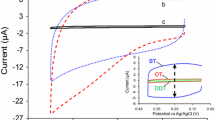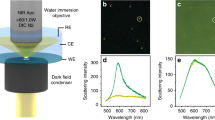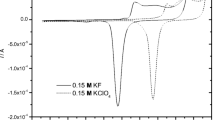Abstract
Spectroscopic ellipsometry (SE) has been used to investigate the adsorption of yeast cytochrome c (YCC) on gold films. YCC is a prototypical molecular system to evaluate the sensitivity and reliability of optical methods in probing conformational changes upon adsorption at surfaces. Measurements have been performed in situ in aqueous solutions at room temperature. We have applied to monolayer-thick YCC films the same scheme of analysis of SE spectra used in our recent works on thiolate self-assembled monolayers on gold, exploiting the so-called δΨ and δΔ difference spectra. A comparison between δΨ and δΔ spectra obtained from YCC adsorption on flat and cluster-assembled nanostructured gold films, obtained by supersonic cluster beam deposition is proposed. For both kinds of substrate δΨ and δΔ, difference spectra show well-defined features related to molecular optical absorptions typical of the so-called heme group, in particular the Soret band at about 410 nm. These features appear in the same position found for molecules in solution, suggesting that YCC native conformation is maintained upon adsorption also in the case of a substrate with typical roughness at the nanoscale.




Similar content being viewed by others
References
Toccafondi, C., Prato, M., Maidecchi, G., Penco, A., Bisio, F., Cavalleri, O., et al. (2011). Optical properties of yeast cytochrome c monolayer on gold: An in situ spectroscopic ellipsometry investigation. Journal of Colloid and Interface Science, 364(1), 125–132.
Zharov, V. P., Galitovskaya, E. N., Johnson, C., & Kelly, T. (2005). Synergistic enhancement of selective nanophotothermolysis with gold nanoclusters: Potential for cancer therapy. Lasers in Surgery and Medicine, 37(3), 219–226.
Bauer, G., Hassmann, J., Walter, H., Haglmüller, J., Mayer, C., & Schalkhammer, T. (2003). Resonant nanocluster technology—from optical coding and high quality security features to biochips. Nanotechnology, 14(12), 1289.
Douketis, C., Wang, Z., Haslett, T. L., & Moskovits, M. (1995). Fractal character of cold-deposited silver films determined by low-temperature scanning tunneling microscopy. Physical Review B, 51, 11022–11031.
Carbone, R., Marangi, I., Zanardi, A., Giorgetti, L., Chierici, E., Berlanda, G., et al. (2006). Biocompatibility of cluster-assembled nanostructured TiO2 with primary and cancer cells. Biomaterials, 27(17), 3221–3229.
Raspanti, M., Protasoni, M., Manelli, A., Guizzardi, S., Mantovani, V., & Sala, A. (2006). The extracellular matrix of the human aortic wall: Ultrastructural observations by FEG-SEM and by tapping-mode AFM. Micron, 37(1), 81–86.
Prato, M., Alloisio, M., Jadhav, S. A., Chincarini, A., Svaldo-Lanero, T., Bisio, F., et al. (2009). Optical properties of disulfide-functionalized diacetylene self-assembled monolayers on gold: A spectroscopic ellipsometry study. The Journal of Physical Chemistry C, 113(48), 20683–20688.
Prato, M., Moroni, R., Bisio, F., Rolandi, R., Mattera, L., Cavalleri, O., et al. (2008). Optical characterization of thiolate self-assembled monolayers on Au(111). The Journal of Physical Chemistry C, 112(10), 3899–3906.
Aspnes, D. E., Kinsbron, E., & Bacon, D. D. (1980). Optical properties of Au: Sample effects. Physical Review B, 21(8), 3290–3299.
Barborini, E., Piseri, P., & Milani, P. (1999). A pulsed microplasma source of high intensity supersonic carbon cluster beams. Journal of Physics D: Applied Physics, 32(21), L105.
Wegner, K., Piseri, P., Tafreshi, H. V., & Milani, P. (2006). Cluster beam deposition: A tool for nanoscale science and technology. Journal of Physics D: Applied Physics, 39(22), R439.
Gonella, G., Cavalleri, O., Emilianov, I., Mattera, L., Canepa, M., & Rolandi, R. (2002). Spectro-ellipsometry on cadmium stearate Langmuir–Blodgett films. Materials Science and Engineering: C, 22, 359–366.
Bisio, F., Palombo, M., Prato, M., Cavalleri, O., Barborini, E., Vinati, S., et al. (2009). Optical properties of cluster-assembled nanoporous gold films. Physical Review B, 80(20), 205428.
Bisio, F., Prato, M., Cavalleri, O., Barborini, E., Mattera, L., & Canepa, M. (2010). Interaction of liquids with nanoporous cluster assembled Au films. The Journal of Physical Chemistry C, 114, 17591–17596.
Bisio, F., Prato, M., Barborini, E., & Canepa, M. (2011). Interaction of alkanethiols with nanoporous cluster-assembled Au films. Langmuir, 27(13), 8371–8376.
Louie, G. V., & Brayer, G. D. (1990). High-resolution refinement of yeast iso-1-cytochrome c and comparisons with other eukaryotic cytochromes c. Journal of Molecular Biology, 214, 527–555.
Manas, E. S., Vanderkooi, J. M., & Sharp, K. A. (1999). The effects of protein environment on the low temperature electronic spectroscopy of cytochrome c and microperoxidase-11. The Journal of Physical Chemistry B, 103(30), 6334–6348.
Dragomir, I., Hagarman, A., Wallace, C., & Schweitzer-Stenner, R. (2007). Optical band splitting and electronic perturbations of the heme chromophore in cytochrome c at room temperature probed by visible electronic circular dichroism spectroscopy. Biophysical Journal, 92(3), 989–998.
Levantino, M., Huang, Q., Cupane, A., Laberge, M., Hagarman, A., & Schweitzer-Stenner, R. (2005). The importance of vibronic perturbations in ferrocytochrome c spectra: A reevaluation of spectral properties based on low-temperature optical absorption, resonance Raman, and molecular-dynamics simulations. Journal of Chemical Physics, 123(5), 054508.
Rosenheck, K., & Doty, P. (1961). The far ultraviolet absorption spectra of polypeptide and protein solutions and their dependence on conformation. Proceedings of the National Academy of Sciences, 47(11), 1775–1785.
Kelly, S. M., Jess, T. J., & Price, N. C. (2005). How to study proteins by circular dichroism. Biochimica et Biophysica Acta (BBA; Proteins & Proteomics), 1751, 119–139.
Vroman, L., & Lukosevicius, A. (1964). Ellipsometer recordings of changes in optical thickness of adsorbed films associated with surface activation of blood clotting. Nature, 204, 701–703.
Jonsson, U., Malmqvist, M., & Ronnberg, I. (1985). Adsorption of immunoglobulin G, protein A, and fibronectin in the submonolayer region evaluated by a combined study of ellipsometry and radiotracer techniques. Journal of Colloid and Interface Science, 103(2), 360–372.
Mȧrtensson, J., Arwin, H., Nygren, H., & Lundström, I. (1995). Adsorption and optical properties of ferritin layers on gold studied with spectroscopic ellipsometry. Journal of Colloid and Interface Science, 174, 79–85.
Tengvall, P., Lundström, I., & Liedberg, B. (1998). Protein adsorption studies on model organic surfaces: An ellipsometric and infrared spectroscopic approach. Biomaterials, 19, 407–422.
Goyal, D. K., & Subramanian, A. (2010). In-situ protein adsorption study on biofunctionalized surfaces using spectroscopic ellipsometry. Thin Solid Films, 518, 2186–2193.
Werner, C., Eichhorn, K.-J., Grundke, K., Simon, F., Grählert, W., & Jacobasch, H.-J. (1999). Insights on structural variations of protein adsorption layers on hydrophobic fluorohydrocarbon polymers gained by spectroscopic ellipsometry (part I). Colloids and Surfaces A: Physicochemical and Engineering Aspects, 156, 3–17.
Legay, G., Markey, L., Meunier-Prest, R., & Finot, E. (2007). Measurements of thickness dispersion in biolayers by scanning force microscopy and comparison with spectroscopic ellipsometry analysis. Ultramicroscopy, 107, 1111–1117.
Lousinian, S., & Logothetidis, S. (2007). Optical properties of proteins and protein adsorption study. Microelectronic Engineering, 84, 479–485.
Berlind, T., Poksinski, M., Tengvall, P., & Arwin, H. (2010). Formation and cross-linking of fibrinogen layers monitored with in situ spectroscopic ellipsometry. Colloids and Surfaces B: Biointerfaces, 75, 410–417.
Kriechbaumer, V., Tsargorodskaya, A., Mustafa, M. K., Vinogradova, T., Lacey, J., Smith, D. P., et al. (2011). Study of receptor-chaperone interactions using the optical technique of spectroscopic ellipsometry. Biophysical Journal, 101, 504.
Azzam, R. M. A., & Bashara, N. M. (1987). Ellipsometry and polarized light. North Holland.
Tompkins, H. G., & Irene, E. A. (2005). Handbook of ellipsometry. Springer.
Fujiwara, H. (2007). Spectroscopic ellipsometry: Principles and applications. New York: Wiley
Prato, M., Gussoni, A., Panizza, M., Cavalleri, O., Mattera, L., & Canepa, M. (2008). Cu underpotential deposition on Au controlled by in situ spectroscopic ellipsometry. Physica Status Solidi (c), 5(5), 1304–1307.
Bordi, F., Prato, M., Cavalleri, O., Cametti, C., Canepa, M., & Gliozzi, A. (2004). Azurin self-assembled monolayers characterized by coupling electrical impedance spectroscopy and spectroscopic ellipsometry. The Journal of Physical Chemistry B, 108(52), 20263–20272.
Synowicki, R. A., Pribil, G. K., Cooney, G., Herzinger, C. M., Green, S. E., French, R. H., et al. (2004). Fluid refractive index measurements using rough surface and prism minimum deviation techniques. Journal of Vacuum Science & Technology B: Microelectronics and Nanometer Structures, 22(6), 3450–3453. doi: 10.1116/1.1813455
Krivacic, J. R., & Urry, D. W. (1970). Ultraviolet and visible refractive indices of spectro-quality solvents. Analytical Chemistry, 42(6), 596–599.
De Feijter, J. A., Benjamins, J., & Veer, F. A. (1978). Ellipsometry as a tool to study the adsorption behavior of synthetic and biopolymers at the air–water interface. Biopolymers, 17, 1759–1772.
Sonesson, A. W., Callisen, T. H., Brismar, H., & Elofsson, U. M. (2007). A comparison between dual polarization interferometry (DPI) and surface plasmon resonance (SPR) for protein adsorption studies. Colloids and Surfaces B: Biointerfaces, 54, 236–240.
Tie, Y., Calonder, C., & Van Tassel, P. R. (2003). Protein adsorption: Kinetics and history dependence. Journal of Colloid and Interface Science, 268, 1–11.
Kozma, P., Kozma, D., Nemeth, A., Jankovics, H., Kurunczi, S., Horvath, R., et al. (2011). In-depth characterization and computational 3D reconstruction of flagellar filament protein layer structure based on in situ spectroscopic ellipsometry measurements. Applied Surface Science, 257(16), 7160–7166.
Edmiston, P. L., Lee, J. E., Cheng, S.-S., & Saavedra, S. S. (1997). Molecular orientation distributions in protein films. 1. Cytochrome c adsorbed to substrates of variable surface chemistry. Journal of the American Chemical Society, 119(3), 560–570.
Li, Y.-T., Hsieh, Y.-L., Henion, J. D., & Ganem, B. (1993). Studies on heme binding in myoglobin, hemoglobin, andcytochrome c by ion spray mass spectrometry. Journal of the American Society for Mass Spectrometry, 4, 631–637.
Neuman, O., & Naaman, R. (2006). New optical absorption band resulting from the organization of self-assembled monolayers of organic thiols on gold. Journal of Physical Chemistry B, 110(11), 5163–5165.
Hamoudi, H., Prato, M., Dablemont, C., Cavalleri, O., Canepa, M., & Esaulov, V. A. (2010). Self-assembly of 1,4-benzenedimethanethiol self-assembled monolayers on gold. Langmuir, 26(10), 7242–7247.
Hövel, M., Gompf, B., & Dressel, M. (2010). Dielectric properties of ultrathin metal films around the percolation threshold. Physical Review B, 81(3), 035402.
Acknowledgements
We thank Valentina Locaso and Tethis Srl (Milano) for the nanostructured gold films fabrication. We also acknowledge Ennio Vigo for technical assistance and Dr. Alessandra Pesce for helpful discussions.
Author information
Authors and Affiliations
Corresponding author
Rights and permissions
About this article
Cite this article
Toccafondi, C., Prato, M., Barborini, E. et al. Yeast Cytochrome c Monolayer on Flat and Nanostructured Gold Films Studied by UV–Vis Spectroscopic Ellipsometry. BioNanoSci. 1, 210–217 (2011). https://doi.org/10.1007/s12668-011-0024-3
Published:
Issue Date:
DOI: https://doi.org/10.1007/s12668-011-0024-3




